The Golden Age of Lemsford
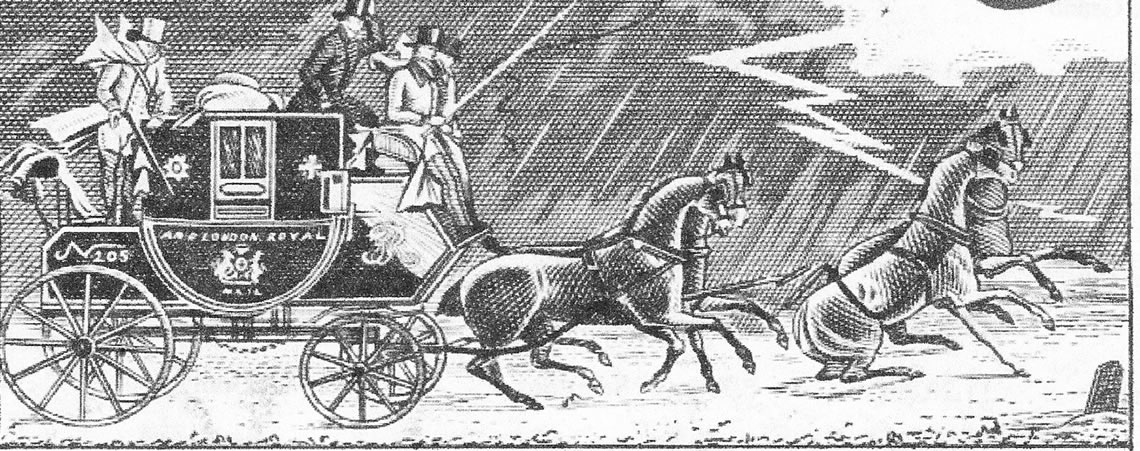
The Golden Age of lemsford had 11 pubs view them all - To view Gallery Click Here
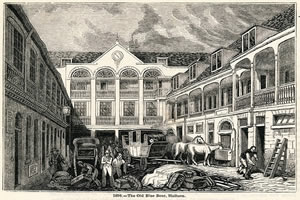 When the Great North Road went through Lemsford it is said as many as 150 coaches a day. Carriages and wagons would pass through the village daily. All the inns would have offered food and drink for the travellers. Accommodation would be provided if required. Wheelwrights and blacksmiths were available to service the wagons and horses. Stabling for the horses would also have been provided.
When the Great North Road went through Lemsford it is said as many as 150 coaches a day. Carriages and wagons would pass through the village daily. All the inns would have offered food and drink for the travellers. Accommodation would be provided if required. Wheelwrights and blacksmiths were available to service the wagons and horses. Stabling for the horses would also have been provided.
100 coaches passing through Lemsford every 24 hours
Why was the 1800s the golden age? This was the time before the railways formed the principle transport to the North. The principle transport was the stagecoach. In 1836 over 340 routes were licensed to travel to and from London. Most coaches 4 passengers inside and 11 on the roof, nearly all had distinctive names and operated from Inns in and around the city of London.
Once again if we take the year 1836 Hertfordshire had nearly 100 coaches passing through it every 24 hours, including 11 mail coaches which left londons general post office at 8-00pm. if you add the private wagons you can imagine the hustle bustle of life in Lemsford. In our records we have time tables for the Post office coaches to Leeds (took 20 hrs 52 minutes), The Glasgow coach (44 hours) as well as private companies, Express (Barton upon Humber) The times (Bedford) The perseverance (Boston) all of these coaches would leave the great inns of London such as ‘ Bull & Moth’ St Martins le Grand, ‘George & Blue Boar’ Holborn, (image above from London Past website) ‘Kings Arms’ Snow Hill ‘Boar and Castle’ Oxford street and many more great inn of London.
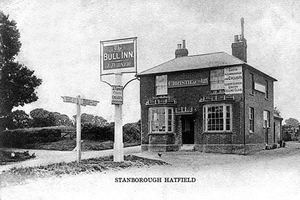
The Bull at Stanborough
So what was Lemsford like at this time? The obvious life of the village was the inns and pubs, these could be found on the main Great North road that went through the village, the route started in the area called Stanbrough which had a pub called the Bull on the road leading in the coaches would follow the road now known as Brocket Road and when they reached the Church ( Built in 1859) you could stop at the Wagon and Horses. Read Article - View Gallery

The Wagon & Horses
‘ The Wagon & Horses’ (or Waggoners) was located opposite St Johns Church at the site now occupied by Gosmore House. It was owned by a member of the Slight family who was a waggoner by trade. When he decided to open his house to the public for the sale of ale the choice of name was obvious! In 1842 it was owned by a Mr Mills and later by a Mr Cox. In 1882 the owner was Charles Higby Lattimore. The occupants were George and Lydia Hill with six children and Charles and emma Smith (nee Hill) with one child. George was a watercress man. Eventually however, Lord Mount Stephen and the vicar, the Rev F. Coggin, prevailed upon the brewers to close the pub down because of its proximity to the church. It wasclosed circa 1890 and demolished. It was replaced in 1900 by a house for a resident nurse to serve Lemsford & Ayot Green/Ayot St Peter areas, and was later described as a Nursing Home.One Source has called the Inn ‘The star’ anther ‘The Church Gate’ . It is thought that the latter name, however, may have been used merely as a description of the Inns location. In the same way ‘The Chequers’ was often called ‘The Crooked Chimney long before that name was officially adopted.
As we leave the Wagon and horses we turn down past the church down the hill to the village.The next Inn was a major stopping point for the stage coaches, on the left is the Roebuck Inn. Read Article - View Gallery
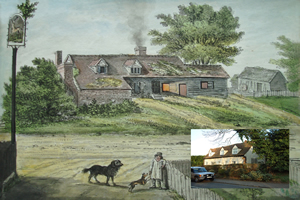
The Roebuck
‘The Roebuck’ stood on the opposite side of the road to the presentRoebuck Farm house (No 57). It was situated just down the hill from where the pair of cottages, Nos, 40 and 42, now stand and in the grounds of what is now Mill House (No 38). It is first mentioned in 1756. The 1838 Land Rgistry lists James Cheshire ( or Chester) as the tenant of several fields, a cottage and of the ‘ Roebuck Inn’ which was owned by Lord Melbourne. Circa 1860 it was being run by john Chesher until it was closed down in about 1880.
We leave the Roebuck and enter the centre of the Village and on the right we find ‘ The Sun Inn’ the best example of a classic English Village Pub and unchanged in appearance from the days of the stagecoach Read Article - View Gallery.
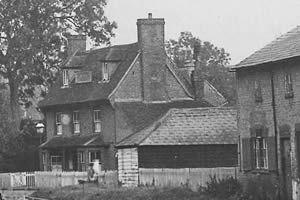
The Sun Inn
The first time the Sun Inn is mentioned as an ale house is in 1717. The licensee was Widow Ann Gilbert, however trouble was bought about by disorderly customers in 1718 and she was forbidden to use the house ‘ The signe of the Sun’ as an ale house as they did not have a licence. The next time we read about The Sun Inn or The Rising Sun was from the mid 1700s it was known as a hostelry and for some of the time as a butchers Shop. From 1780 to 1850 it was the family home of the clark,the Allen, Crabb and Jon Marshall. In 1855 it was acquired by the Hatfield Brewery. The brewery is believed to have started in Henry VIII time around 1582 and owned by Searancke family. It left the direct male line of the Searancke family in 1779 and was passed to a nephew Francis Carter Nicholl who became mayor of St Albans in 1801, but as a condition in the will Nicholl had to change his name to Searancke. In 1816 the brewery was sold to Joseph Bigg a Stanstead brewer who had been his partner for a number of years. By 1819 Bigg had became bankrupt and the brewery was acquired by Joseph Field, who owned it from 1819 to his death in 1836. The brewery had been let to Alfred prior & Co from 1830 an owned the freehold from 1836. Alfred died in 1876 and gave his son Edward the option of buying it, which he did in 1878 and was known as E Pryor & Co. In 1902 it was known as Pryor Reid & Co and amalgamated with Glover & Co of Harpenden. The brewery closed in 1920 when P.C. Reids only son Geoffrey Reid was killed in action in 1915 and he had nobody to take over the business. It was sold to Benskins of Watford.
When acquired by the Hatfield brewery the landlord was John Males who was also the village wheelwright, it then was owned by Thomas Hasley, who also owned cows and milk was sold at the back door. In 1901 George Hasley was the publican and the pub remained the home of the Hasleys until late 1940s, photos show the Pub with stables which we know were there in the early 1800s. when Arther Moyse became the Landlord. He was followed by Arnold Schofield in about 1956, Arnold had a wife, Marjorie and a young daughter. During this period the wall between the public bar and saloon bar was removed and a single bar set up and food was offered. The pub had been sold to the Benskins brewery in 1920. Later in the 1970s the office of fair trading decreed that no one brewery should have a monopoly of trade in one area , Benskins had the monopoly at this time and they were obliged to release the sun to Ind Coope. At this time mine hosts were Graham and Shirley and was one of my regular haunts it was and still is one of the most popular pubs in the area and I have had the pleasure of knowing it under Louis Smith and today Laura and Ian.
My favourite story about the Sun is about Pat Dellar who use to take her puma, leopard or lion from the kennels in Green Lanesshe also had an elephant she parked in the car park. she owned Lemsford kennels I believe she did some filmwork with her "zoo".She also bred Boxer dogs. Someone who went round to pick up some dog food..He walked into the sittingroom and there was a lion on the settee.. I think he left rather quickly.
The next pub we visit is the Long Arm And Short Arm just over the bridge located on the old Great North Road which ran up the hill to the Waggoners
Read Article - View Gallery.
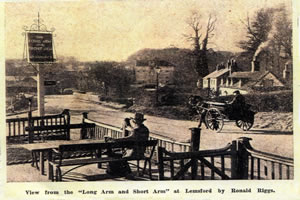
The Long Arm And Short Arm
The Long Arm and Short Arm was originally a cottage and blacksmiths shop and dates from 1734. In 1853 the buildings were described in an auction catalogue as a brick built and tiled beer house, bakers and grocers shop, bake house and premises. In 1859 the beer house was owned by George Tims and the 1861 census give the occupant as Amos Young and his occupation as ‘Beer Retailer’. Records show it was first licensed in 1875 by Elizabeth Lattimore of Wheathampsead. In 1881 the census shows the Lattimores were landlords and a James Lawrence was the Publican. The property was owned by Hon H Cowper of Brocket Halland in 1891 Thomas Lawrence the 4th son of James has taken over as the beer retailer at the age of 26, he is also described as a shoe maker
McMullens the present owners acquired the property before 1900, our records show an article about ‘Peter the Poacher’ from Hertfordshire countryside in 1991. Peter McMullen was known as Peter the Poacher( I do not know why) he started his business in Hertford in 1827. in Hertford as in Lemsford beer was brewed on the premises and people bought it on a regular basis from a alehouse ( there were 10 in Hertford) for home consumption. He started as a freelance Cooper for some of these brewers. He decide to try his hand at brewing as Hertford had high quality water due to gypsum in the soil, in later years he bored a deep wellto maximise this. He moved to the Bridge Brewery and had access to the river Lea (The same river that flowed through Lemsford) He bought his first pub in 1836, the articles mentions several pubs he acquired but not the Long & Short, we have photos in the archive that show the Long & Short at the turn of the century with the MvcMullens sign above the door.
It was referred to as a beer house up to 1920 and its owner James Smith was described as a Beer retailer. In 1928the pub was one of several in the area had its licence refused. The licensed was regained and at this time the ale house was pulled down and the present public house was built it opened in 1929.
The name remains a riddle to this day. The theory’s of how it got its name vary from the different lengths of he 2 roads that left the village or a signal board that was there before the bridge was built in 1755 it denoted the depth of water in the ford, Long arm signalled deep and short arm shallow. A third reason has been put forward by one of our members Jeremy Summers that a coachman with reins of one pair in his left hand or long arm and the other pair on his short arm as denoted on the pub sign Read Article - View Gallery.

The Angel
‘The Angel’ originates from about 1720.It was situated in the extreme north – east corner of the parish about 100 yards south of the present ‘ Waggoners’ at Ayot Green and approximately opposite the entrance to the existing Brickwall cottage in Brickwall Close (the Great North Road prior to the building of the motorway). In 1733 the ‘inn-holder’ Ambrose Bone left it to his wife, and three years later it passed to her nephew Lawrence Currell. In 1773 it was owned by Lord Melbourne and later by his descendants. In the 1838 Land Registry the occupant of the Inn and premises is given to John Nightingale. ‘The Angel’ was demolished in 1850 on the order of Lady Palmerston of Brocket Hall. It is said that there is a depression in the ground marked by a group of poplars that identifies where the building was located but this is no longer apparent. The licence passed to ‘The Waggoners. Read Article - View Gallery

The Waggoners at Ayot Green
The ‘Waggoners’ at Ayot Green was smaller than the ‘Angel’. The first licensee is believed to have been Joseph Howard. In 1851 the licensee was James Aldridge. In 1881 it was owned by J.W. Kent, brewers in St Albans. It was held on a lease from a Mrs Batchelor of Croxley Green in 1904. It later became a Whitbread house. It is now a listed building; it is thought that parts date back to the 16th century.
Mrs Eleanor Cliffe was licensee in 1937. By the 1950s the volume and speed of the traffic using the Great North Road made it to dangerous to use the front door of the pub. Entry was therefore by a rear door, which also provided easy access for those customers coming straight off the golf course. (Truly the nineteenth hole) At this time there was no bar as such within the pub . Drinks were purchased at a hatchway in a corridor just inside the rear entry door. Drinks would be taken into a small ‘snug’ to the left of the now sealed off front door or into a larger room on the right. Dominoes and cribbage were popular pastimes for the regulars. There was a large open fireplace there. The licensee was Jack Cliffe and later the licence passed to his daughter Clara Cliffe. When Clara had to go to hospital in the late 1960s the pub was run on a rota basis by the customers, including Ferd and Ann Fitt, Clara still being the licensee
With the opening to the motorway in 1973 ‘ The Waggoner’s’ was by – passed and isolated on a short length of the great North Road which now became a cul-de-sac and was renamed Brickwall close. In the old days when a pub was by passed by the re-routing of a main road this would have meant loss of trade and possible closure but here the pub was rejuvenated, a proper bar was built, the front door at the road was re-opened and the road itself effectively became a car park. Kathy Blacker was the publican at this time( circa 1986 – 1998) and managed the house with her family. Also at about this time the drink/drive laws were coming into force and more and more pubs were increasingly offering food as a means of continuing trade. This was so at ‘The Waggoners’ where in addition to offering food at the bar, a restaurant was added. After briefly being in the hands of the Red Rooster organisation it again became a family managed pub in 1999 with a Joe and Dawn McCulloch in charge. The licensees then passed to Roberto Agesta and Virginie Fauque and it became a popular place for diners who appreciate good food with the ambience and charm of a very old building. In 20** the new licensees Aude and Laurent Brydniak took over and continued to add to the reputation for fine wines, real ale and French cuisine.Our next pub an last pub is the red Lion via the cottage where th Horse & Jockey stood. Read Article - View Gallery
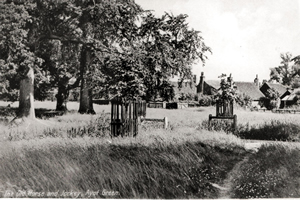
‘Horse & Jockey’ (Ayot Green)
The Horse & Jockey was a public house that formed part of what is now known as No 5 Ayot Green which is set back from the left side of the road as one approaches from the Great North Road. In 1838 the present building was two cottages and seems to have remained so throughout the 19th century. In the 1838 register boyh were owned by John Messer. One of the cottages was let but he occupied the other and this was the public house. It was established about 1820 and its name was connected with the racecourse in Brocket Park. In 1871 John Messers son Albert held the licence. In 1891 census Ernest Jaques was the publican but it is suggested in”Ayot St Peter – A Parish History” that this was perhaps an erroneous rendering of ‘ Jeakings’ but there is no evidence given to substantiate this. Later however , a William Jeakings became the last licence before it closed shortly after the end of WW1. William died in December 1922 at the age of 56. His Wife died in January 1947 at the age of 74. They had a son Ernest who was still living at the family home, No 8 Ayot Green, in1965. Read Article - View Gallery
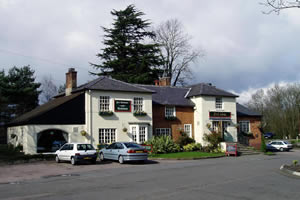
Red Lion
This inn was established in 1715 as the ‘Shoulder of Lamb’ but was renamed ‘The Red Lion’ in1746. In 1838 ‘Jeeves Cottage alongside’ The Red Lion’ was occupied by John Chesher and he was probably the licensee. In 1860 he was running the ‘Roebuck Inn’ at Lemsford. Lord Melbourne was the owner of Jeeves Cottage and of ‘The Roebuck Inn’.
The Great North Road which passed in front of “The Red Lion’ , had been a turnpike road since 1725 when the Welwyn Turnpike Trust was set up. There were three toll gates, at Brickwall, Ayot Green and Welwyn, where toll charges were collected from road users. The charges generally paid with greatreluctance, were intended to pay for maintenance and improvement of the road. On the night of the 1st November 1877 the duties of the Welwyn Turnpike trust were taken over by the Highway Board and toll gates were removed allowing the traffic to pass along the road free of charge. The licensee of ‘The red Lion’ Benjamin Easterbee this popular event by setting up a barrel of beer on Ayot Green and serving free beer to all.
In 1940s there were a single petrol pump located in the forecourt of the pub, convenient to students living at nearby de Havilland technical School hostel at Sherrrards House. On one occasion a student who was getting petrol there ( at 2s/2d a gallon) was told by the attendant the “an aeroplane had just crashed round the back of the pub” and discovered a Tiger Moth from the DH club at Panshanger upside down and looking very damaged. There was no sign of the pilot – he was in the pub with a beer in one hand and the phone in the other, calling the club to collect the remains of the aircraft! Apparently its engine had stopped when ‘looping the loop’ and had no option but to attempt an immediate crash landing. Also located outside the pub long before the petrol pump was a wooden trough where horse and cattle could slake their thirst.The Red Lion is now owned by Mitchells & Butlers Leisure Retail Limited and is a characterful building filled with cosy corners, comfy armchairs, open log fires and a unique dining room. Chef’s freshly prepared menu and our carefully selected wines, ales and lagers are served daily from lunch right through until dinner. Read Article - View Gallery
Stan Borrie was a founder member of Lemsford Local History Group. He produced most of the research for the ‘Pubs of Lemsford Parish’ and published a booklet for the group. He died in 2010 and is sadly missed.
When the Great North Road went through Lemsford it is said as many as 150 coaches a day. Carriages and wagons would pass through the village daily.
All the inns would have offered food and drink for the travellers. Accommodation would be provided if required. Wheelwrights and blacksmiths were available to service the wagons and horses. Stabling for the horses would also have been provided.Read More about the Golden Age Of Lemsford - Click Here

